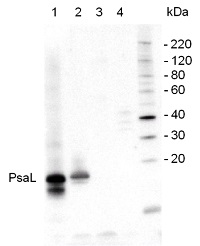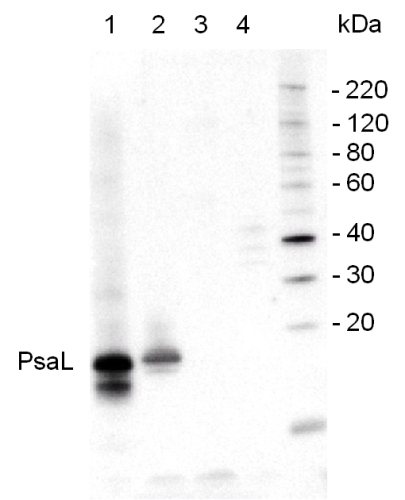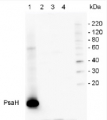1

Anti-PsaL | PSI-L subunit of photosystem I
AS06 108 | Clonality: Polyclonal | Host: Rabbit | Reactivity: A. thaliana, H. vulgare, N. tabaccum, S. oleracea
- Product Info
-
Immunogen: KLH-conjugated synthetic peptide derived from PsaL protein sequence from Arabidopsis thaliana (At4g12800). This sequence is well conserved in most mono- and dicots but not in Physcomitrella patens.
Host: Rabbit Clonality: Polyclonal Purity: Serum Format: Lyophilized Quantity: 200 µl Reconstitution: For reconstitution add 200 µl of sterile water Storage: Store lyophilized/reconstituted at -20°C; once reconstituted make aliquots to avoid repeated freeze-thaw cycles. Please remember to spin the tubes briefly prior to opening them to avoid any losses that might occur from material adhering to the cap or sides of the tube. Tested applications: Western blot (WB) Recommended dilution: 1 : 1000 (WB) Expected | apparent MW: 18 | 17-18 (Arabidopsis thaliana)
- Reactivity
-
Confirmed reactivity: Arabidopsis thaliana, Hordeum vulgare, Nicotiana tabaccum, Spinacia oleracea Predicted reactivity: Nicotiana benthamiana, Monocots (Zea mays)
Species of your interest not listed? Contact usNot reactive in: Cyanobacteria - Application Examples
-
Application example

2 µg of total leaf protein of Arabidopsis thaliana (1) and Hordeum vulgare (2) and total cellular protein of Chlamydomonas reinhardtii (3) and Synechococcus PCC 7942 (4) isolated with PEB (AS08 300) were separated on 4-12% Nupage Bis-Tris gels in in MES running buffer (Invitrogen) at 200V for 35 minutes. Proteins were transferred for 80 minutes at 30V to a PVDF membrane pre-wetted in methanol and equilibrated in 1X transfer buffer. Blots were blocked immediately following transfer in 2% blocking reagent in 20 mM Tris, 137 mM sodium chloride pH 7.6 with 0.1% (v/v) Tween-20 (TBS-T) and probedwith anti-PsaL (AS06 148 1:1000) and secondary HRP-conjugated goat anti-rabbit antibody (1:50 000) for 1 hr in TBS-T containing 2% blocking reagent. Antibody incubations were followed by washings in TBS-T (15, +5, +5, +5 min). All steps were performed at RT with agitation. Signals was detected using chemiluminescence detection reagent, according to the manufacturers instructions and a CCD imager (FluorSMax, Bio-Rad)
Application examples: 
Reactant: Nicotiana tabacum (Common tobacco)
Application: Western Blotting
Pudmed ID: 28180288
Journal: J Exp Bot
Figure Number: 5A
Published Date: 2017-02-01
First Author: Schöttler, M. A., Thiele, W., et al.
Impact Factor: 6.088
Open PublicationImmunoblot analysis of photosynthetic complex accumulation in wild-type tobacco and the two ?psaI lines grown under low, intermediate, and high-light conditions. Because the accumulation of most tested proteins was highest under high-light conditions, lanes one to three contain samples diluted to 25%, 50%, and a 100% sample of wild-type tobacco grown under high-light conditions, to allow for semi-quantitative determination of changes in protein abundance. Lanes four and five contain the two transplastomic lines grown at 1000 µE m?2 s?1. Lanes six to eight contain wild-type tobacco and the mutants grown at intermediate light intensities, and lanes nine to eleven contain samples grown at low light intensities. For PSII, the accumulation of the essential subunits PsbB (CP43) and PsbD (D2) and the LHCB1 antenna protein were determined, while for the cytochrome b6f complex, the accumulation of the essential redox-active subunits PetA (cytochrome f), PetB (cytochrome b6), and PETC (Rieske FeS protein) was tested. AtpB was probed as an essential subunit of the chloroplast ATP. For PSI, in addition to the three essential plastome-encoded subunits PsaA, PsaB, and PsaC, the accumulation of the nuclear-encoded subunits PSAD, PSAH, PSAK, PSAL, and PSAN and of the four LHCI proteins (LHCA1, LHCA2, LHCA3, LHCA4) was determined. Finally, we examined the accumulation of Ycf4, the chloroplast-encoded PSI-biogenesis factor encoded in the same operon as PsaI, and the nuclear-encoded assembly factor Y3IP1.
- Background
-
Background: PsaL (PSI-L) is a conserved subunit of type I photosynthetic reaction centers (Photosystem I, PSI). PSI is an integral membrane multi-protein complex that catalyzes the electron transfer from plastocyanin (or cytochrome c6) to ferredoxin (or flavodoxin). Psa-L is binding pigments and has been shown to be involved in trimerization of PSI in cyanobacteria (but not in plants) and bind pigments in plants and cyanobacteria.In plants and algae Psa-L is nuclear encoded and imported post-translationally into the chloroplast where it inserts into the thylakoid membrane.
- Product Citations
-
Selected references: Wang et al. (2020). Post-translational coordination of chlorophyll biosynthesis and breakdown by BCMs maintains chlorophyll homeostasis during leaf development. Nat Commun. 2020; 11: 1254.
Koh et al. (2019). Heterologous synthesis of chlorophyll� b� in� Nannochloropsis salina� enhances growth and lipid production by increasing photosynthetic efficiency. Biotechnol Biofuels.� 2019 May 14;12:122. doi: 10.1186/s13068-019-1462-3. eCollection 2019.
Schöttler et al. (2017). The plastid-encoded PsaI subunit stabilizes photosystem I during leaf senescence in tobacco. J Exp Bot.Ã? 2017 Feb 1;68(5):1137-1155. doi: 10.1093/jxb/erx009.
Sook Seok et al. (2013). AtFKBP16-1, a chloroplast lumenal immunophilin, mediates response to photosynthetic stress by regulating PsaL stability. Physiologia Plantarum, DOI: 10.1111/ppl.12116.
Bock (2012). The plastid genome-encodedYcf4 protein functions as a non-essential assembly factor for photosystem I in higher plants. Plant Physiol. ahead of print. - Protocols
-
Agrisera Western Blot protocol and video tutorials
Protocols to work with plant and algal protein extracts - Reviews:
-
This product doesn't have any reviews.



